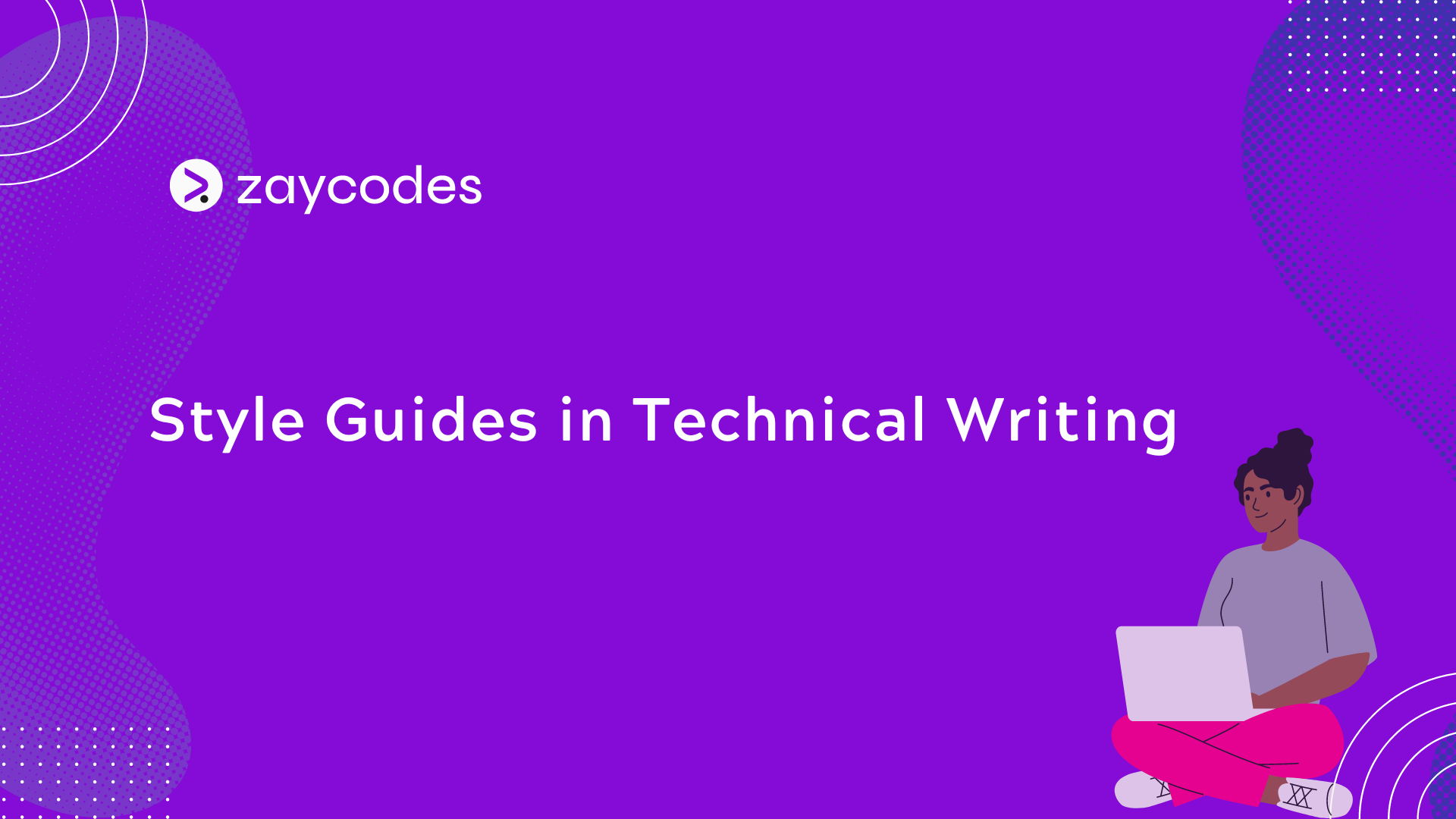Style Guides in Technical Writing
 Zainab Daodu
Zainab Daodu
Introduction
Technical writing requires precision, clarity, and adherence to specific guidelines. Technical writers play an essential role as the bridge between complex information and its audience in various industries. One essential tool that aids technical writers in maintaining consistency in their documents is style guides.
This article is a guide to the different style guides in technical writing.
What is a Style Guide?
A style guide in technical writing is a comprehensive set of standards and guidelines that ensure uniformity and coherence in written content. It serves as a roadmap for writers, providing insights into grammar, punctuation, formatting, and even industry-specific terminologies. By following a style guide, writers ensure that their documents are not only accurate but also accessible and understandable to their target audience.
Benefits of Style Guides
Adhering to style guides offers a range of benefits that contribute to effective communication and successful content creation:
Professionalism: Well-structured documents reflect professionalism, enhancing the reputation of both the writer and the organization.
Time Efficiency: Writers spend less time making decisions about their writing choices, streamlining the content creation process.
Clear Communication: By following established guidelines, writers ensure that their content is clear, concise, and easy to comprehend.
Error Reduction: Style guides address common errors and pitfalls, reducing the chances of grammatical and formatting mistakes.
Examples of Technical Writing Style Guides
Let’s explore some examples of style guides commonly used in technical writing:
Microsoft Writing Style Guide
The Microsoft writing style guide emphasizes clarity and user-friendliness, offering specific guidelines for creating user manuals, online help, and software documentation. It addresses terminology, writing for a global audience, and best practices for presenting technical information. Following this guide ensures that content maintains a consistent voice and format, enhancing brand recognition and user understanding. This guide encourages you to write as you speak, use fewer words, and make your point quickly. Here are some of the sections in this guide;
Voice: The Microsoft brand has three voice principles: warm and relaxed, crisp and clear, and ready to lend a hand.
Accessibility Guidelines: This section gives an overview of the accessibility standards, which include how to write for all abilities, and how to use colors and patterns in text.
Acronyms and Abbreviations: Clarity and voice, can be negatively affected by acronyms and abbreviations. While some acronyms are commonly known by their full names, others are unknown or only known to a small subset of customers. This guide has standards for using acronyms in your content.
Google Developer Documentation Style Guide
Targeting technical writers working on software development documentation, the Google Developer Documentation Style Guide provides editorial guidelines for writing consistent Google-related documentation, but it can also be adapted for your use case. Below are some sections of this style guide;
General principles: This section highlights guidelines like avoiding third-party sources, avoiding the use of jargon, and crafting conversational documentation for a worldwide readership to encourage diversity.
Tone and Content: This section gives pointers on how to use a conversational and friendly tone in writing and how to write for a global audience. It also contains a list of words to avoid and recommends alternatives. It emphasizes user needs, logical structure, inclusive language, and accurate technical information.
Language and grammar: This section shows how abbreviations are used. It emphasizes the use of second-person pronouns and active voice in writing. This also contains a list of words that can be used or avoided in your content.
Punctuation: This provides an editorial style guide for using commas, parentheses, hyphens, colons, etc.
Some sections guide writers on how to format and organize their content and handle computer interfaces.
Digital Ocean Style Guide
This guide focuses on technical writing for software engineering and server administration. Here’s a link to best practices for DigitalOcean's tutorials It has four sections that cover style, structure, formatting, and terminology;
Style: The style section gives directions on how to write comprehensive documentation for readers of all experience levels; for example, they recommend that you explicitly include every command needed to do a task when writing tutorials.
Structure: DigitalOcean’s article structure begins with the introduction, prerequisites, etc., and ends with the conclusion. They also have article templates for conceptual, procedural, and software development tutorial articles.
Formatting: DigitalOcean tutorials are formatted in the Markdown markup language. This section shows how you should write headers, code blocks, code block labels, etc.
Terminology: They’ve standardized some of the vocabulary and word usage because technical publications and tutorials will use a lot of it.
Apple Style Guide
For writers involved in creating content for products and platforms, the Apple Style Guide offers guidance on maintaining a consistent tone and voice. It covers aspects such as UI text, app names, and guidelines for creating user-friendly content, marketing materials, and technical documentation. It outlines rules for capitalization, abbreviations, and the usage of terminologies. This style guide has the following sections:
Style and usage: This section provides the usage format for specific numbers and terminologies.
Writing inclusively: This guide encourages writers to promote diversity and inclusivity in their content.
Units of measure: This provides rules and examples for writing units, symbols, prefixes, and abbreviations.
Technical notation: This contains style and usage standards for the syntax and code, especially for developer documentation.
International style: This section includes general guidelines for writing country names, country codes, currency codes, language codes, dates and times, telephone numbers, etc.
GitLab Documentation Style Guide
The guide covers various aspects, including writing principles, formatting conventions, and structuring content. It encourages the use of plain language, active voice, and concise explanations. The guide also advises on using appropriate headings, bullet points, and images to enhance readability. Consistency in terminology, code examples, and links is highlighted to ensure a good user experience. It encourages a docs-first method which implies that the implementation, use, and troubleshooting of the product are all based solely on the technical documentation. It also gives guidelines on how to write Markdown. Some sections of this guide are;
Voice: The GitLab brand voice supports clear, direct, and precise writing. The goal is to offer information that is simple to look for and scan.
Language: This guide Avoid unnecessary words, be clear, concise, and stick to the goal of the topics written in US English with US grammar, they tend toward lowercase.
Word list: This guide has a list of words to ensure consistency in documentation.
Chicago Manual of Style
The Chicago Manual of Style is a widely recognized style guide used across various disciplines, including academia, publishing, and technical writing. It offers comprehensive guidelines on grammar, punctuation, citation, and formatting. Technical writers often turn to this manual for its detailed instructions on creating clear and concise documents.
Conclusion
Style guides play an essential role in maintaining consistency, accuracy, and professionalism in technical writing. These guides cater to technical writing content. By following the guidelines outlined in these style guides, writers can produce content that effectively communicates complex information, resonates with the intended audience, and upholds the standards of excellence in communication.
Be sure not to miss out! You can find the latest tips, tutorials, and guides on open-source and technical writing on this page.
Subscribe to my newsletter
Read articles from Zainab Daodu directly inside your inbox. Subscribe to the newsletter, and don't miss out.
Written by

Zainab Daodu
Zainab Daodu
I am a technical writer and software developer who is passionate about contributing to open source, improving technical documentation and advocating for gender diversity in open source collaboration.